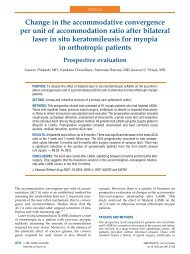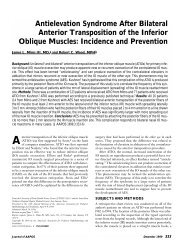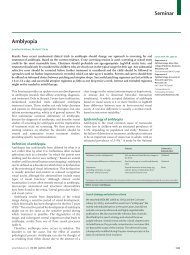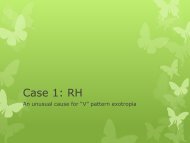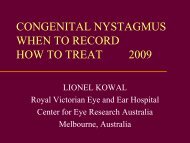What's new AAPOS 2008 - The Private Eye Clinic
What's new AAPOS 2008 - The Private Eye Clinic
What's new AAPOS 2008 - The Private Eye Clinic
You also want an ePaper? Increase the reach of your titles
YUMPU automatically turns print PDFs into web optimized ePapers that Google loves.
PEDIATRICS<br />
Visual Manifestations of Craniofrontonasal Dysplasia.<br />
JPOS 2007; 44:251-254.<br />
Cranifrontal dysplasia is a rare, inheritable syndrome with features of coronal<br />
craniosynostosis and frontonasal dysplasia. <strong>Clinic</strong>al features include brachycephaly,<br />
frontal bossing, orbital hypertelorism, thick, curly hair, longitudinally grooved nails, and<br />
skeletal abnormalities. High prevelance of strabismus has previously been reported. A<br />
44% prevalence of visual impairment was observed in the nine patients identified with<br />
this syndrome. More than half of these patients were identified with potentially<br />
correctable causes of visual loss, including amblyopia and anisometropia. Regular eye<br />
exams in these individuals are recommended in order to identify not only strabismus<br />
(88.9%) but other potentially amenable forms of visual impairment.<br />
Neuroradiographic, endocrinologic, and ophthalmic correlates of adverse<br />
developmental outcomes in children with optic nerve hypoplasia: A prospective<br />
study.<br />
Garcia-Fillon P, Epport K, Nelson M, Azen C et al.<br />
Pediatrics <strong>2008</strong> Mar; 121(3):e653-e659.<br />
<strong>The</strong> authors conducted a prospective study of 73 children who were diagnosed with<br />
optic nerve hypoplasia prior to 36 months of age. <strong>The</strong>y found that 71% of subjects had<br />
developmental delay. Corpus callosum hypoplasia and hypothyroidism were<br />
significantly associated with poor developmental outcomes. <strong>The</strong> authors conclude that<br />
because there is this correlation with developmental delay, all children with optic nerve<br />
hypoplasia should have neuroradiologic and endocrinologic testing for risk factors in<br />
delay and developmental assessment so they may receive early intervention planning if<br />
necessary.<br />
Omega-3 polyunsaturated fatty acid intake and islet autoimmunity in children at<br />
increased risk for Type 1 diabetes.<br />
Norris J, Yin X, Lamb M, Barriga K et al.<br />
JAMA 2007 Sep; 298(12):1420-1428.<br />
Type 1 diabetes is an autoimmune disease that leads to the destruction of insulin<br />
producing beta cells in the pancreas. A previous retrospective study from Norway<br />
showed that children with diabetes were less likely to have been given Cod Liver Oil<br />
during infancy than children without diabetes. In this longitudinal observational study,<br />
children at risk for the development of type 1 diabetes were followed prospectively to<br />
see if there was a correlation between Omega-3 fatty acid intake and the development<br />
of islet autoimmunity. <strong>The</strong> investigators found that dietary intake with Omega-3 fatty<br />
97



